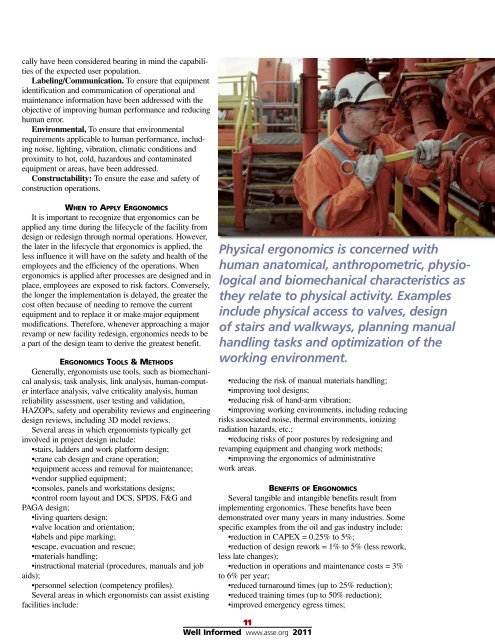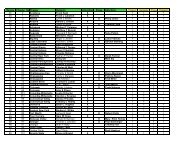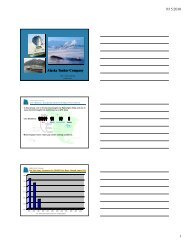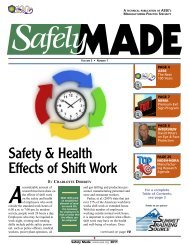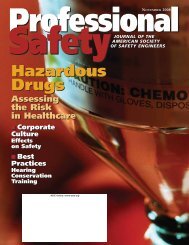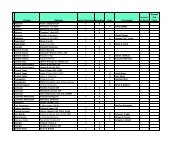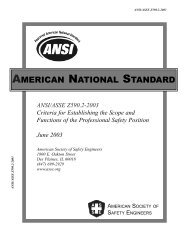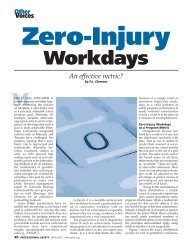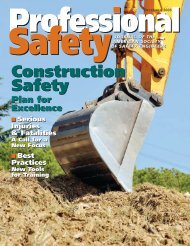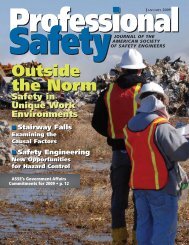OSHA's Flame-Resistant Clothing Policy - ASSE Members
OSHA's Flame-Resistant Clothing Policy - ASSE Members
OSHA's Flame-Resistant Clothing Policy - ASSE Members
Create successful ePaper yourself
Turn your PDF publications into a flip-book with our unique Google optimized e-Paper software.
cally have been considered bearing in mind the capabilitiesof the expected user population.Labeling/Communication. To ensure that equipmentidentification and communication of operational andmaintenance information have been addressed with theobjective of improving human performance and reducinghuman error.Environmental, To ensure that environmentalrequirements applicable to human performance, includingnoise, lighting, vibration, climatic conditions andproximity to hot, cold, hazardous and contaminatedequipment or areas, have been addressed.Constructability: To ensure the ease and safety ofconstruction operations.WHEN TO APPLY ERGONOMICSIt is important to recognize that ergonomics can beapplied any time during the lifecycle of the facility fromdesign or redesign through normal operations. However,the later in the lifecycle that ergonomics is applied, theless influence it will have on the safety and health of theemployees and the efficiency of the operations. Whenergonomics is applied after processes are designed and inplace, employees are exposed to risk factors. Conversely,the longer the implementation is delayed, the greater thecost often because of needing to remove the currentequipment and to replace it or make major equipmentmodifications. Therefore, whenever approaching a majorrevamp or new facility redesign, ergonomics needs to bea part of the design team to derive the greatest benefit.ERGONOMICS TOOLS &METHODSGenerally, ergonomists use tools, such as biomechanicalanalysis, task analysis, link analysis, human-computerinterface analysis, valve criticality analysis, humanreliability assessment, user testing and validation,HAZOPs, safety and operability reviews and engineeringdesign reviews, including 3D model reviews.Several areas in which ergonomists typically getinvolved in project design include:•stairs, ladders and work platform design;•crane cab design and crane operation;•equipment access and removal for maintenance;•vendor supplied equipment;•consoles, panels and workstations designs;•control room layout and DCS, SPDS, F&G andPAGA design;•living quarters design;•valve location and orientation;•labels and pipe marking;•escape, evacuation and rescue;•materials handling;•instructional material (procedures, manuals and jobaids);•personnel selection (competency profiles).Several areas in which ergonomists can assist existingfacilities include:Physical ergonomics is concerned withhuman anatomical, anthropometric, physiologicaland biomechanical characteristics asthey relate to physical activity. Examplesinclude physical access to valves, designof stairs and walkways, planning manualhandling tasks and optimization of theworking environment.•reducing the risk of manual materials handling;•improving tool designs;•reducing risk of hand-arm vibration;•improving working environments, including reducingrisks associated noise, thermal environments, ionizingradiation hazards, etc.;•reducing risks of poor postures by redesigning andrevamping equipment and changing work methods;•improving the ergonomics of administrativework areas.BENEFITS OF ERGONOMICSSeveral tangible and intangible benefits result fromimplementing ergonomics. These benefits have beendemonstrated over many years in many industries. Somespecific examples from the oil and gas industry include:•reduction in CAPEX = 0.25% to 5%;•reduction of design rework = 1% to 5% (less rework,less late changes);•reduction in operations and maintenance costs = 3%to 6% per year;•reduced turnaround times (up to 25% reduction);•reduced training times (up to 50% reduction);•improved emergency egress times;11Well Informed www.asse.org 2011


